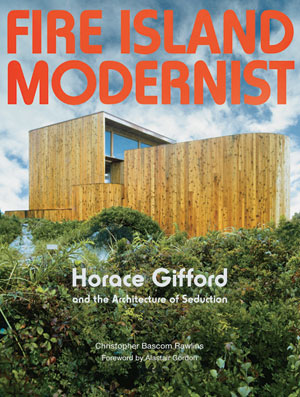Consider this book a handy time machine set to take you to a sun-soaked place in a hedonistic era. Bring your Speedo and Ray-Bans and let go of your hang-ups. Both a cultural history and an architectural meditation, Fire Island Modernist captures the look, feel, and sensation of gay society in the 1960s and '70s that flourished on the sandy shores and shifting dunes of the 31-mile-long barrier island of its title. Separated from the Hamptons by Great South Bay, Fire Island developed a free-spirited, car-free culture radically different from its more upscale neighbor to the northeast.

The book is also an ode to a mostly forgotten architect who designed 78 modern beach houses—mostly on Fire Island, but a few in the Hamptons—starting in 1961 and ending in the 1980s. Like so many of his clients, Horace Gifford fell victim to the AIDS epidemic, dying at age 60 in 1992.
Christopher Bascom Rawlins, himself an architect and part-time resident of Fire Island, discovered Gifford's work piecemeal and, as his book's subtitle says, became seduced by it. Rawlins's clear, graceful prose has just the right tone and style for his subject, and his selection of photographs, drawings, and illustrations brings Gifford's times back to life. Chapter titles such as “Oasis of Free Love,” “Boys in the Sand,” and “Form Follows Foreplay” alert readers that this book is not some musty tome from the shelves of a university library. Photographs of handsome young men cavorting on the beach and striking fashionable poses by the pool add to the book's glamorous ambience. As Alastair Gordon states in his foreword, Gifford's houses “expressed the longings of a culture that had transformed Fire Island into a free-fire zone of social and sexual discovery.”
Rawlins's goal, though, is also to raise Gifford's star in the architectural firmament. “Pairing this well of sensitivity [to the coast] with jazzy improvisations on modernist themes, he perfected a sustainable modernism in cedar and glass, as attuned to natural landscapes as our animal natures,” states Rawlins of Gifford. As seductive as this book is, I'm not convinced that Gifford's houses—sometimes easygoing modern bungalows, sometimes awkward attempts at geometric innovation—truly rise to the highest level of architectural achievement.




Post a comment to this article
Report Abusive Comment